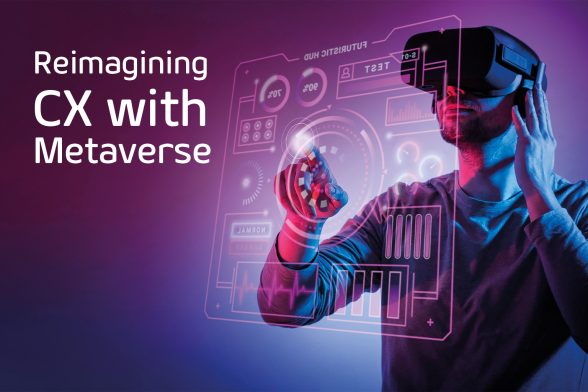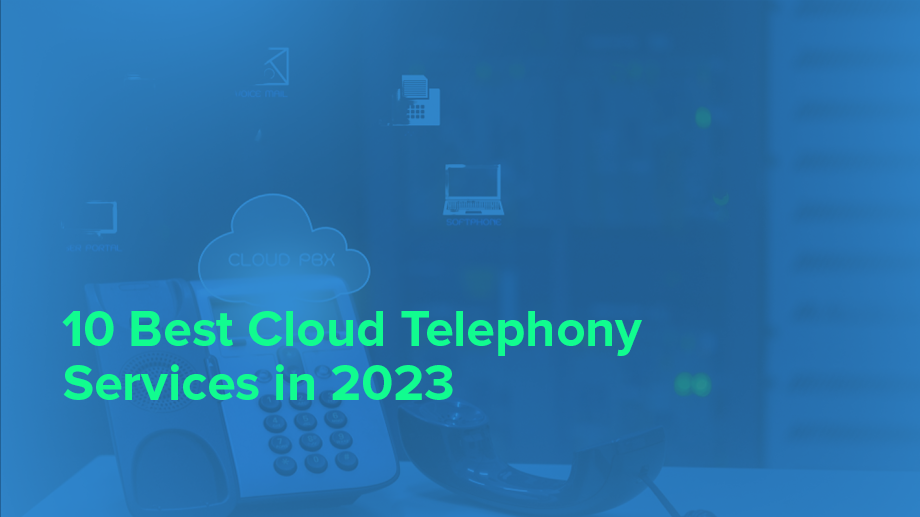- Resources
- Reimagining CX with Metaverse
Reimagining CX with Metaverse

Remember the episode, “USS Callister” from the popular British TV series Black Mirror, where an embittered programmer tortured sentient digital avatars based on his real-life co-workers? It all seemed preposterous until Mark Zuckerberg barged onto the stage in what will be remembered as the metaverse’s Big Bang moment.
In October 2021, Zuckerberg announced he is committed to building a new digital world and was renaming its holding company Facebook as Meta. It caught everyone by surprise but since then, everyone has been in awe of it and is latching on to the bandwagon. So, what is it?
What is Metaverse?
The concept is fuzzy but when it was launched, Facebook described it as “a hybrid of today’s online social experiences, sometimes expanded into three dimensions or projected into the physical world.” Does it sound complicated – something only those so-called nerds indulge in? You might think it sounds like something from a comic book, except it isn’t!
Metaverse has vast possibilities to reshape how we work, play, socialize, and shop. Think of how you experience the internet today through your devices. You’ve everything at your disposal – on-demand but you are not immersed in it. Everything is pushed to you in some form – be it an email, a notification, information, etc.
Imagine a virtual world with your own avatar, just like that Black Mirror episode. You can socialize with your friends in a coffee shop, shop, play games, even attend a concert (remember the latest Ariana Grande virtual show in Fortnite?)! It’s a whole new world that exists in parallel with your real world.
This is the essence of the metaverse.
American sci-fi author Neal Stephenson used the term “metaverse” in his novel, “Snow Crash” for the first time in 1992, where he described a virtual world inhabited by avatars of real people. Since then, several movies have explored the concept – prominent among them, The Matrix.
Video games brought the concept much closer. In the 2000s, a game platform called Second Life introduced the virtual universe where gamers can meet others, attend concerts by artists like U2, and work. It was kind of a parallel economy at the time, with its own currency, convertible to dollars. But it was quickly forgotten, ironically with the arrival of Facebook! Post that there were several video games. But the one game that catapulted metaverse into millions of homes was Fortnite, and later, Roblox.
Why is Metaverse more relevant now?
Before the rebranding of Meta, such virtual world experiences were thought of as “geek…ish” phenomena. However, when Zuckerberg announced his vision, people realized its true potential. A report said around 38% of global consumers are already familiar with the concept.
In a matter of months, metaverse has emerged as a hot medium for brands to deliver great customer experiences. Brands were already relying on more advanced technologies like AI and machine learning to better understand and reach their audiences, transform consumer experiences, and storytelling.
And in the metaverse, they can leverage interactive avatars to serve and engage customers wherever they are and in new ways.
- MetaLives – Constituting ideas such as digital ownership and content creation through digital art and nonfungible tokens.
- MetaSpaces – Virtual venues or activations that blend aspects of the virtual world with the real one.
- MetaBusinesses – Leveraging “gamevertising,” where brands appear within the realm of video games.
- MetaSocieties – Characterized by people cultivating “hyper-real identities online.”
- The fashion giant Ralph Lauren recently released a collection on the gaming platform, Roblox and even runs a virtual coffee shop.
- Microsoft released its brand-new product – Mesh which offers shared mixed-reality experiences leveraging distance collaboration holograms. The firm also has big plans for facilitating surgeries through HoloLens.
- P&G has already debuted Beauty Sphere in Metaverse with an immersive digital narrative about sustainability and products from the brand’s beauty portfolio.
What does this mean for CX?
As we said earlier, the metaverse isn’t that open and connected yet. But the success of Fortnite and Roblox is paving the way for more virtual worlds with their own economies. Imagine your customers entering the metaverse. They could digitally test your products, try out options, or interact (rather than chat or email) with your hologram support team to learn more about the features.
In fact, PwC’s Global Entertainment & Media Outlook 2021–2025 report forecasts that VR will become the fastest-growing content segment from 2020 to 2025 at a CAGR of 30%. Technologies like VR, AR, and MR (core components of metaverse) have the potential to offer customer experiences that brands can’t otherwise offer in the real world.
For instance, in the metaverse, Ikea could let you design your own space by giving you different items in a virtual version of your home. You will be able to see if the new model of your refrigerator would fit in a particular space or if the kitchen countertop would match your overall color scheme. A clothing or shoe store can set up a virtual store where customers could see the items in 3D without traveling to a physical store and can try them out in virtual changing rooms on a digital avatar that matches their body type.
But aren’t you already doing all or some of it through apps now? In metaverse, there will be a difference. If you’ve recently tried Meta’s VR meeting software, Horizon Workrooms, you’d understand. There are a few things in there that help you understand how Meta is envisioning the future of work in virtual worlds – things you can’t do in your regular Zoom or Teams calls. It’s a bit of an MR which combines aspects of the virtual world with the real one.
For instance, you can turn your face around and see your co-worker as if you are sitting at the same table together, you can hear their voices more loudly when you are facing them than when you are turned away, you could pinch your fingers to draw a note on a virtual chalkboard wall. Best of all you can see meeting participants all hang out in the same “room” together, instead of the clobbered heads you see right now in your video calls.
Reimagining CX with digital avatars
The need for hyper-personalized interactions is only increasing. Customers want omnichannel experiences – and most importantly, similar interactive experiences to what they find on the web. And talking digital avatars with gestures and facial expressions have the power to take this a step further. Customer interactions can finally move from transactional to more experiential ones.
Digital avatars are infinitely scalable, which means one avatar can talk to thousands of customers simultaneously, and each customer will get their own personalized and empathetic experience. It can happen at any time of day, in a safe and immersive environment. It means brands can see substantial cost savings.
These avatars also lend a natural, interactive, and entertaining touch to the overall experience. Though the current ones aren’t quite there yet, in the future, the digital avatars will be able to get 90% of emotional communication right, including body language, micro-expressions, and emotional feedback. Plus, as the interactions are digital, brands can record and get a lot of quality stats that can tie into the business’s KPI to improve operations.
But can such avatars also prove useful to upsell or cross-sell? Experts have talked about use cases like a liquor store, where customers can engage with a talking avatar to find the perfect wine pairing for their night or evening in a fun and engaging way. In the home improvement stores, these avatars can help customers pick out the perfect color and type of paint for their new home projects, or enhance business experiences by greeting customers when they walk in the door.
This brings us to another question.
How are digital avatars different from chatbots?
There is a significant difference. Dave AI points to the simple fact that a physical representation of a human-like avatar provides a more immersive experience than a chatbot because you can see the avatar visually. Having said that every brand has different values and a different personality, and it’s not often represented through chatbots.
There are a couple of differences:
- Unlike the regular automated customer service chatbots, digital avatars are completely autonomous. The founders of Soul Machines believe behind every digital avatar, there is a Digital Brain — a patented technology that combines neural networks and biological models to synthesize the capabilities of a human brain.
- They have the ability to learn and react to consumers. When a customer talks to a digital avatar, the avatar sees and hears the customer in real-time through the customer’s microphone and webcam. It reacts to the customer’s words and body language and learns from the interaction to tailor the user experience.
- They can remember previous experiences of interacting with you and adjust their personalities based on those interactions.
- They can also speak in various languages, with nuanced accents.
Reimagining contact center experience in the metaverse
For contact centers, this would be an opportunity to reinvent themselves. They already know omnichannel support is critical for the modern customer experience. They can open their own virtual rooms in the metaverse.
Customers can simply walk into a bank wearing a VR headset in the virtual world and interact with the contact center’s hologram support team. Your digital avatar can explain the details of a product and even guide towards a digital demo. Customers don’t have to write a long email or wait in a call queue.
And it’s not even a remote possibility. Dubai has already opened the world’s first Metaverse customer happiness service center, which will offer health services virtually. Customers can use the virtual room to seek information, submit documents, pay fees, and interact with real people’s faces instead of avatars.
Of course, this is just an example; possibilities are endless for contact centers in other industries like healthcare, tourism.
The future of CX with digital avatars
The future looks bright. There are infinite exciting possibilities for the brands to explore. The PwC report predicts a phenomenal rise of 23.5 million jobs worldwide in AR and VR technologies by 2030 for training, work meetings or to provide better customer service.
The digital avatars in the metaverse will create more empathetic, approachable, and personalized customer experiences. And customers will have a choice to interact with these avatars in their own safe spaces, without the anxiety that can accompany encounters with humans. When there is no fear of being judged, the depth of customer connections with brands becomes deeper.
Will metaverse truly have the potential to become the next internet? Only time will tell. For now, we foresee one major challenge that brands must overcome before a unified metaverse customer experience becomes the norm. It remains to be seen if a single company would “own” a VR space, or various companies would be open to set aside their profits and user count considerations and interconnect their worlds, so people can roam freely between them. That would be the essence of a true metaverse!







